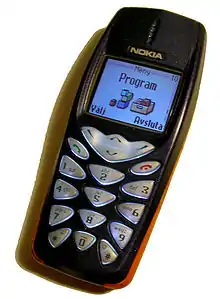Nokia 3510
The Nokia 3510 is a mobile phone for the GSM network, introduced by Nokia on 12 March 2002.[1] The phone was the first Nokia phone to bring GPRS internet services to the mass market.[2]
 | |
| Manufacturer | Nokia |
|---|---|
| Compatible networks | |
| First released | 2002 |
| Predecessor | Nokia 3310 (3510) Nokia 3395 (3590) Nokia 3360 (3560) |
| Successor | Nokia 6010 Nokia 3100 |
| Related | Nokia 3410 |
| Dimensions | Length: 11.9 cm x Depth: 2.28 cm x Width: 5.00 cm |
| Mass | 111 g (3.92 oz) |
| Removable storage | No |
| Battery | NiMH 950/1000mA·h BLC-2
|
| Display | Monochrome, 96 x 65 pixels (3510/3590) or 12-bit color CSTN, 96 x 65 pixels (3510i/3520/3530/3560/3595) |
| Rear camera | No |
| Connectivity | GPRS |
An enhanced version, Nokia 3510i, introduced some time later on 6 September 2002 and released in December 2002.[3] It was one of the first phones with a color display. The phone has a Nokia Series 40 96 x 65 user interface. The 3510 has the multi-button user interface of the classic Nokia 2110. Along with Nokia 7210, it was the first Nokia device on the mass market with polyphonic ringtones (they were already on the Nokia 7650).[4]
GPRS is used for data transmission and mobile Internet WAP service. The Nokia 3510i model supports Java 2 ME that makes it possible for users to download and use Java applications (not supported by 3510), background images and polyphonic ringtones. The phone supports SMS and MMS messaging.[5][6] The 3510i is of the DCT4 hardware generation.
There was also a gaming-enhanced Xpress-on cover released as an official accessory for the 3510.[7]
Variants
The Nokia 3510i was being sold in Europe, Russia, Middle East and Africa, while the Nokia 3530 was being sold in Asia-Pacific, which operate on GSM 900/1800, and features a more conventional keypad.
The Nokia 3590 was a version of the 3510 for the North American market. It operates on GSM-1900 and GSM-850 networks. The phone was at one time available through the former AT&T GoPhone prepaid mobile phone service.
The Nokia 3595 operates on North American GSM-1900 and GSM-850 networks. Prior to the release of the 3595, the Nokia 3560 was released, with a more standard arrangement of the keypad, and operating on TDMA and AMPS for roaming. IS-136. The 3560 was released in the Spring of 2003 and was sold through early 2004 when TDMA accounts were no longer being activated. The 3560 came with more preloaded content than the 3595 since the phone was primarily designed for prepaid TDMA customers. The 3595 contains less preloaded content but enables users to download new content using GPRS, or MMS. The 3595 is often thought of as the GSM equivalent to the TDMA 3560, although it is actually an upgrade to the Nokia 3590 handset. The 3595 and 3590 faceplate and keypad buttons are interchangeable.
The Nokia 3595 includes an IM client for AOL Instant Messenger and ICQ in the latest firmware revisions.
A newer version of the 3595 is the Nokia 6010, which improves on the keypad and gives the phone a more business-oriented look. The 6010 also has corrected all of the software bugs that were previously found in the 3595 handset. The 6010 was discontinued by all major GSM carriers except T-Mobile in 2006.
Technical data
| Model | 3510 | 3510i |
|---|---|---|
| CPU | UPP8M v1.1 | UPP8M v2.2[8] |
| UEM | UEMK v4.4 | UEMK v4.4[8] |
| RF | MJOELNER S2006 | MJOELNER S2006[8] |
| Flashmemory | 876,701 bytes | 876,701 bytes[9] |
UEM - Universal Energy Management
Accessories
| Type | Partsnumber |
|---|---|
| Battery | BLC-2 LiON ; BMC-3 NiMH (3510 only)[10][11] |
| Headset | HDC-5 (standard); HDB-5 (boom); HDD-1 (dual ear); HDC-10 (retractable); CARK-134 (car kit); PPH-1 (no holder+antenna); HDR-1 (music);[12] HDE-2; LPS-3 (inductive) |
| Data cable | OEM only or DIY |
| Charger | DDC-1 (standard); ACP-12 (fast & light) |
Data port:
| ↑ Towards battery connector ↑ | ||
| NC | 1-GND | 2-Vpp |
| 3-Fbus RX | 4-Mbus | 5-Fbus TX |
Fbus and Mbus uses 3,3 volt levels.
References
- https://www.golem.de/0203/18740.html
- The Nokia 3510 brings GPRS and polyphonic sounds to the consumer market Archived 2012-03-25 at the Wayback Machine - Nokia press release March 12, 2002
- http://gsmonline.pl/artykuly/nowa-nokia-3510i
- http://news.bbc.co.uk/1/hi/in_depth/sci_tech/2000/dot_life/2115548.stm
- Review Nokia 3510i - mobile-review
- Review: Nokia 3510
- http://www.imobile.com.au/accessories/default.asp?ID=accessoct0201&print=yes
- "nokia-tuning.net - Nokia PCB IC list / compatibility for DCT-4 phones". 090421 nokia-tuning.net
- "CodeDump: Linux meets Nokia 3510i". 090421 de-brauwer.be
- "cnc phone warehouse - Nokia Genuine Accessories". Archived from the original on 2009-09-12. Retrieved 2009-09-10. 090910 cncphones.com.au
- techbuy.com.au - Nokia BMC-3 - NiMH Battery, 900mAh for 3310, 3330, 3350, 3510 & 3315, read 2012-09-12
- "empty". 090910 nds2.nokia.com
- "Nokia 3510 Connector Pinout - AllPinouts". 090910 allpinouts.org
External links